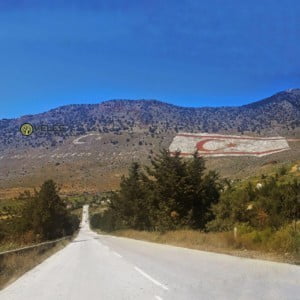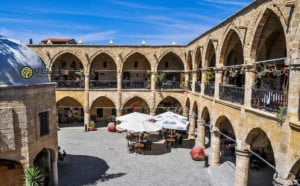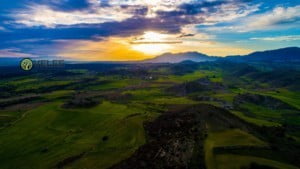Geography of Northern Cyprus.
 There is no doubt that everyone dreams of visiting Cyprus at least once in their life and seeing with their own eyes the gifts of this unique island. Many people are interested in the geography of Northern Cyprus. The uniqueness of the island of Cyprus is in everything – in geographical location, history, climate, beautiful beaches, legends and historical monuments. Residents of many countries around the world have made Cyprus their favorite holiday destination. This is understandable: the combination of affordable prices, ideal climatic conditions, natural resources and, of course, the sea and sunshine make your stay in Cyprus unique and unforgettable. The geography of North Cyprus includes: geographical location, weather characteristics, agriculture, population and language. Geographically, the island belongs to Asia, occupies an area of 9,251 sq.m (the territory of Northern Cyprus is 3355 sq.m.). It is located in the northeast of the Mediterranean Sea, being the third largest island in the region. 57.6% of the total territory belongs to the Republic of Cyprus, 36% to Northern Cyprus or the TRNC. 3.7% is occupied by the buffer zone under UN control and 2.7% of the territory belongs to the United Kingdom, where military bases are located. Despite its small area, only 100 km from north to south and 240 km from east to west, the natural gifts of Cyprus are surprisingly diverse. There are mountain ranges, rocky shores, kilometer-long sandy beaches. The plains and natural ravines seem to have been painted by a romantic artist trying to reproduce paradise on his canvas.
There is no doubt that everyone dreams of visiting Cyprus at least once in their life and seeing with their own eyes the gifts of this unique island. Many people are interested in the geography of Northern Cyprus. The uniqueness of the island of Cyprus is in everything – in geographical location, history, climate, beautiful beaches, legends and historical monuments. Residents of many countries around the world have made Cyprus their favorite holiday destination. This is understandable: the combination of affordable prices, ideal climatic conditions, natural resources and, of course, the sea and sunshine make your stay in Cyprus unique and unforgettable. The geography of North Cyprus includes: geographical location, weather characteristics, agriculture, population and language. Geographically, the island belongs to Asia, occupies an area of 9,251 sq.m (the territory of Northern Cyprus is 3355 sq.m.). It is located in the northeast of the Mediterranean Sea, being the third largest island in the region. 57.6% of the total territory belongs to the Republic of Cyprus, 36% to Northern Cyprus or the TRNC. 3.7% is occupied by the buffer zone under UN control and 2.7% of the territory belongs to the United Kingdom, where military bases are located. Despite its small area, only 100 km from north to south and 240 km from east to west, the natural gifts of Cyprus are surprisingly diverse. There are mountain ranges, rocky shores, kilometer-long sandy beaches. The plains and natural ravines seem to have been painted by a romantic artist trying to reproduce paradise on his canvas.
History of Cyprus
 The history of Cyprus is steeped in legends and myths and is a history of conquest and possession of the island by powerful civilizations. For history lovers, the island will become an inexhaustible source of new knowledge about ancient cultures and world traditions. The British heritage is felt in Cyprus in the present, but not only. Left-hand traffic and British-style electrical outlets are reminiscent of colonial times. The British are one of the many nations living peacefully in Cyprus. Guaranteed sun for 300 days a year, clear waters of the Mediterranean Sea, friendly Cypriots and loyal laws of Cyprus make it possible for tourists from many countries of the world to spend an unforgettable vacation here. And for those who decide not to part with the island for a long time – the opportunity to purchase real estate in Cyprus.
The history of Cyprus is steeped in legends and myths and is a history of conquest and possession of the island by powerful civilizations. For history lovers, the island will become an inexhaustible source of new knowledge about ancient cultures and world traditions. The British heritage is felt in Cyprus in the present, but not only. Left-hand traffic and British-style electrical outlets are reminiscent of colonial times. The British are one of the many nations living peacefully in Cyprus. Guaranteed sun for 300 days a year, clear waters of the Mediterranean Sea, friendly Cypriots and loyal laws of Cyprus make it possible for tourists from many countries of the world to spend an unforgettable vacation here. And for those who decide not to part with the island for a long time – the opportunity to purchase real estate in Cyprus.
North Cyprus – Climate / Weather Conditions in Cyprus.
The choice of the island of Cyprus by tourists as one of the favorite vacation destinations is not accidental, and is based, first of all, on its excellent climatic conditions, which are determined by the location of the island in the Eastern Mediterranean and the tropical Mediterranean climate. It is these factors that allow tourists to enjoy the unique climatic and weather conditions of Cyprus at any time of the year. But, even taking into account its geography, Cyprus has been noted in all works on the study of the climate on the planet “as unique for its location”. Long dry summers and short winters allow vacationers to enjoy 9 sunny months of the year. The beach season lasts from May to October. The average annual temperature is 19 degrees and the water temperature is 21 degrees. At the height of summer, at the end of July and the beginning of August, the air temperature can reach 40 degrees. It is these weather conditions that allow rare species of sea turtles to lay their eggs on the sandy shores of the Mediterranean Sea. Residents and tourists of the island have repeatedly witnessed the spectacular excavation of baby turtles. And it is on summer days that you can endlessly admire the calm azure sea going beyond the horizon, and the blue sky without a single cloud, and not worry that the weather may deteriorate.
Velvet Season
Autumn in Cyprus is truly the velvet season. Although the main flow of tourists visits Cyprus during the summer months, it is the September and October days that offer exceptional weather conditions. This is the time of the year when the heat subsides, and the air temperature does not rise above 25-27 degrees, and the sea caresses the waters warmed up during the summer. This is the time when Cyprus offers the vibrant colors of nature. Tourists who visit Northern Cyprus in the autumn call their vacation nothing more than a fairy tale. The decline in the tourist flow begins in November, in accordance with the drop in temperature to 20 degrees. At this time of the year, the first rains are possible. The winter months are characterized by a decrease in temperature to 15 degrees during the day and to 5 at night. In winter, short-term precipitation in the form of snow is possible in the Kyrenia Mountains, and rain is possible on the coast. January and February are the coldest months of the year. However, at this time of the year, Cyprus is painted green. In the mountains and foothills, a variety of flowers bloom, many of which grow only in Cyprus.
North Cyprus – Regions and Agriculture.
 The territory of the Turkish Republic of Northern Cyprus is divided into 5 administrative regions: Guzelyurt (Morphou), Girne (Kyrenia), Iskele (Trikomo), Gazimagusa (Famagusta), Lefkosa (Nicosia). Studying the geography of North Cyprus, we can see that in the recent past, North Cyprus was an exclusively agrarian country, where production from agriculture was the basis of the economy. The climate and natural conditions are perfectly conducive to this. However, now the situation has changed and the sectors of education and tourism have come to the forefront of the economy. There is no doubt that the most fertile lands of Cyprus are concentrated in its northern part. Firstly, the Mesaoria Valley is the main area for planting and cultivating crops. Secondly, the Karpaz Peninsula has always been considered the best place in Cyprus for growing tobacco. Thirdly, the regions of Kyrenia and Guzelyurt are the center of citrus tree cultivation.
The territory of the Turkish Republic of Northern Cyprus is divided into 5 administrative regions: Guzelyurt (Morphou), Girne (Kyrenia), Iskele (Trikomo), Gazimagusa (Famagusta), Lefkosa (Nicosia). Studying the geography of North Cyprus, we can see that in the recent past, North Cyprus was an exclusively agrarian country, where production from agriculture was the basis of the economy. The climate and natural conditions are perfectly conducive to this. However, now the situation has changed and the sectors of education and tourism have come to the forefront of the economy. There is no doubt that the most fertile lands of Cyprus are concentrated in its northern part. Firstly, the Mesaoria Valley is the main area for planting and cultivating crops. Secondly, the Karpaz Peninsula has always been considered the best place in Cyprus for growing tobacco. Thirdly, the regions of Kyrenia and Guzelyurt are the center of citrus tree cultivation.
Geography of Northern Cyprus: employment of the rural population. In total, there are about 195 villages and small settlements in Northern Cyprus. The rural population continues to produce various crops. Such as wheat, citrus fruits, olive and carob trees, melons, grapes, figs, potatoes, etc. Tangerines, limes, oranges and grapefruits are the main production of citrus plants. Three types of orange fruits are popular in North Cyprus: Jaffa, Valencia and Washington. On certain days of the week, bazaars are held in each city, where you can buy fresh vegetables and fruits from all over the northern part of the island. Olive groves, carob plantations, almond and citrus orchards are a unique asset of the island. A small percentage of the harvest of these crops is exported mainly to Turkey. However, most of it is used for the needs of the local population. Olive and fig trees are the main suppliers of oil, syrups. They are used for delicacies made by local cooks. And, of course, when making meze.
Northern Cyprus – population, language.
Since the partition of the island in 1974, the vast majority of Greek Cypriots have resided in the Republic of Cyprus. And Turkish Cypriots live in Northern Cyprus. The capital city of Nicosia (Lefkoşa) is the only one in the world that is divided into two parts. According to statistics, more than 300,000 people live in Northern Cyprus. However, the latest census, which did not give accurate results, indicates the possibility of a larger population. The overwhelming majority of the population in the TRNC are Turkish Cypriots and immigrants from Turkey, Anatolian Turks. A small percentage of the population are Greek Cypriots and Maronites. According to the 2006 census, 55% of the total population of Northern Cyprus lives in cities. More than 20% of the population living in Turkish Cyprus are foreign nationals. Among them are Turks, English, Russians, Filipinos, Germans, Ukrainians, Kazakhs, Bulgarians, and many other nationalities. The official language is Turkish, but the local population speaks a regional dialect quite different from mainland. English is used everywhere. First of all, thanks to the education, which in most schools and universities in Northern Cyprus is in English. As well as the residence of a large number of English-speaking people in Northern Cyprus. In recent years, the flow of tourists from the CIS has increased and the Russian language is becoming popular. Most businesses have Russian-speaking staff. Source: Free Internet Article prepared by: Julia Ozerce Ask your question directly to Veles experts.
Source: Free Internet
For a residence permit +90 (533) 826-04-49, buying or selling real estate +90 (542) 882-84-49, issuing apostilled powers of attorney +90 (542) 879-84-49, translation of documents +90 (533) 840-84-49, obtaining visas to the USA, Canada and other countries +90 (533) 833-33-98 – please contact Veles Property.
Read more articles about North Cyprus here.
Follow the developments in Northern Cyprus in our Telegram and Instagram
Watch all our videos on the YOUTUBE channel VELES


